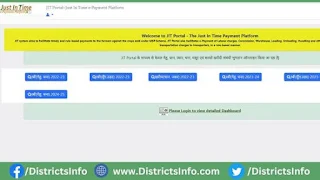
JIT Portal
Why Use JIT Portal?
1) Timely Payments: Farmers receive payments promptly for their crops sold under the MSP scheme.
2) Transparent Transactions: The platform ensures transparency in payment processes.
3) Efficient E-Payments: Societies, procurement centers, and transporters also benefit from streamlined e-payments.
4) Crop Coverage: JIT covers crops such as wheat, rice, sorghum, chickpeas, lentils, and mustard.
How to Check Farmer Payment Status on JIT Portal
1) Visit the JIT Portal official website: https://jit.nic.in/.
2) Click on the “Payment Status” button on the homepage.
3) Select the relevant season (Rabi or Kharif) and the year.
4) Choose the category (e.g., Aadhaar Number).
5) Enter your Aadhaar Number in the provided field.
6) Click on the “Know Payment Status” button.
JIT Login Process
If you’re a registered user, follow these steps to log in to the JIT Portal:1) Visit the JIT Portal: https://jit.nic.in/.
2) Navigate to the login section.
3) Enter your credentials (username and password).
4) Solve the captcha.
5) Click on the login button.
3) Enter your credentials (username and password).
4) Solve the captcha.
5) Click on the login button.
Features of the JIT Portal
1) Payment Tracking: Farmers can track their payment status online.
2) Rule-Based Payments: Ensures payments are made according to predefined rules.
3) Secure Transactions: Follows strict security protocols.
4) Crop-Specific Payments: Covers various crops sold under the MSP scheme.
FAQs (Frequently Asked Questions)
Can I check my payment status using my bank account number?
Yes, you can track your payment status through your bank account number on the JIT Portal.
What crops are covered by JIT?
JIT covers crops such as wheat, rice, sorghum, chickpeas, lentils, and mustard.
Is the JIT Portal secure?
Yes, it follows stringent security measures.
How often are payment statuses updated?
Payment statuses are typically updated promptly after transactions.
Can societies and transporters also use the JIT Portal?
Yes, JIT facilitates payments for societies, procurement centers, and transporters.

